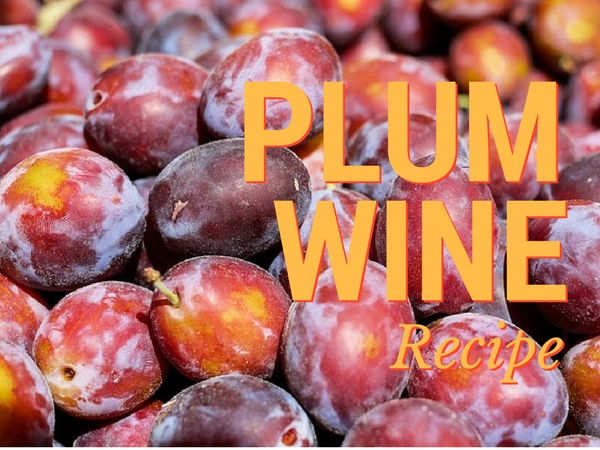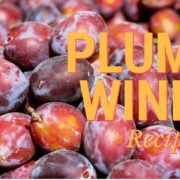Simple & Easy Plum Wine Recipe
Plum wine is one of my favourites. Plums come in many different forms, sharp, sweet, yellow, red or purple. You have plums suited for cooking whilst others are best eaten straight from the tree.
The great thing about them though is if you have a tree nearby you can usually get quite an impressive glut of them, depending on the year and they make a fantastic wine. This Plum wine recipe is simple and easy and it doesn’t matter what
variety of plums, whether they are Victoria, Goldens or Damsons.

Table of Contents
So Many Types Of Plum
As there are so many different types of plums is makes the finishing wine a little variable, as an example, you get some plums that are nearly black in colour, these are going to make a much darker wine than victoria plums for instance which are a more blushed pink colour.
There are some basic rules of thumb for getting the best wine whatever kind of plums you use, firstly, you want to get the ripest fruit possible. The riper the fruit the higher the concentrations of sugar and juice and this always makes for a better-finished wine. Plum wine can have a tendency to be a tad thin-bodied and mild-flavoured so harvesting your plums at the point where they are most fully flavoured is key to the success of your wine.
Plum trees are pretty common in the UK and more often than not, if you have a plum tree in your garden, you will have a glut around the end of August or September. Plum trees can be really productive and you only really need around 1.5 – 2kg per gallon of plum wine so you will have more than enough.
If you want to make this plum wine but don’t have any trees nearby then you can buy plums in. I would recommend you still wait until the fruit is in season rather than buying imported fruit. British fruit when in season tends to have a slightly fuller flavour and because they aren’t travelling as far the plums will be riper and have higher sugar content.
Preparing Plums For Wine Making
To prepare the fruit for wine making you will need to pick through the plums and discard any bad or damaged fruit, give them a wash and then remove the stem and the stones. You should leave the skin on the fruit as this will provide colour and a small amount of tannin which is desirable. Cut the fruit into quarters over a bowl to save all the juices that come out of them.
What You’ll Need To Make Plum Wine – Makes 1 gallon / 4.5 litres
The equipment needed for this plum wine recipe is fairly straightforward. You will need the following items, you can pick up any equipment you do need here.
- Fermenting Bucket
- Demijohn
- Medium Pan
- Funnel
- Syphon
- Potato Masher
- Fine Straining Bag
- Airlock & Bung
Plum Wine Ingredients
- 1.8kg Ripe Plums prepared as above
- 1.2kg of Sugar
- 3.9 litres of Water
- 1 Campden Tablet
- 1/4 tsp Wine Tannin
- 1 tsp Acid Blend
- 1 tsp Yeast Nutrient
- 1 tsp Pectic Enzyme
- 1 Sachet of Wine Yeast
Method
- Place the wine straining bag in the sanitised fermentation bucket into this add the prepared plums. Mash the plums with a sanitised potato masher to break them up and free the juices.
- In a medium pan combine the water and sugar and bring to a boil, ensuring all the sugar is fully dissolved. Once boiling turn off the heat, and pour the hot sugar solution over the plums secured in the straining bag.
- Allow to cool to room temperature and then add the Campden tablet, tannin, acid blend and yeast nutrient and mix thoroughly. 12 hours after this add the pectic enzyme to the must and mix again.
- After 24 hours have passed you can sprinkle the sachet of yeast onto the surface of the must. Allow fermenting for around a week stirring daily. If you have a hydrometer take a reading just before adding the yeast.
- After a week lift out the straining bag and allow to thoroughly drain. Let it settle for a few days and then rack the wine into a clean and sanitised demijohn, attach a bung and airlock and leave the wine to condition and settle for around a month.
- As the wine clears and the sediment builds up rack to a clean demijohn again. I like to leave this wine in the demijohn for around 4-5 months and then bottle it. This plum wine is fairly dry but it is also particularly good if you like sweeter wines, to learn how to back sweeten this wine then see this guide.




” After a week lift out the straining bag and allow to thoroughly drain ” . . . . ..
Can you squeeze the bag at all to help ?
You can, although I prefer not to as this can extract astringent flavours and I feel it makes the wine a little harder to clear.
do you have to remove the plum stones at the start ?
many thanks
Pete
Yes, I like to remove the stones. They add a woody astringency that makes the wine bitter in my opinion.
If I want to make a larger quantity, can I just double the ingredients or doesnt it work that way.
Thanks david.
Yes, you would scale up the recipe as you describe. Double the quantity would double the ingredients.
would you double the yeast too or would a 5gm pack be enough?
Would it affect then wines natural fermentation if i added a small amount of
red grape concentrate 250 ml before racking in to demijohn
It will add a small amount of fermentable sugar which will slightly boost the ABV. It is a good idea for boosting flavour and colour so give it a go.
What measurement of wine yeast
Is a sachet?
They are most commonly 7 grams
Hi Neil, should i add a campden tablet everytime i rack?
Thanks
Hiya,
My plum wine is due to be bottled next month but is still opaque looking, all the other recipes have worked perfectly but this one is stubborn, any ideas on how to clear it or if I should scratch this one off as a failure?
TIA x
Hi Ashley, you may find given a little more time the wine will clear on its own. Haze will not effect the flavour at all so you can bottle a cloudy wine if it is really stubborn.
If you want to clear it quickly you can try adding wine finings. These are additives that will force particles out of suspension. This article – https://homebrewanswers.com/winemaking-chemicals-additives/ will provide a little more information.
Hope this helps.
Should I attach an airlock to the second demijohn or just a bung?
Either is fine as long as CO2 has stopped being produced.
Thanks
I’ve made this a few times, it benefits from Pectolase when crushing the fruit. Personally, I wash and crush the fruit in warm water, and pectolase then fill up the fermenting bin. Leave plenty of space as it will bubble up a lot.
Hi.
If I’m going to add grape concentrate to my plum wine, when is the best time to do it?
Grape concentrate can go in at the beginning with the sugar or at any point before pitching yeast. If fermentation has already started that is fine too as long as there is yeast in suspension.